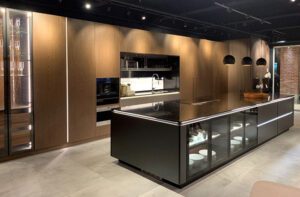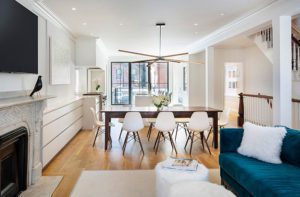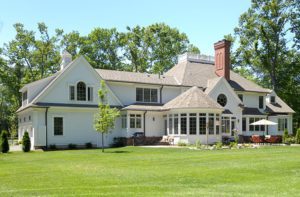The Magic Touch
July 12, 2011
Text by Robert Kiener Photography by Peter Aaron/Esto
Trust. It’s a necessary element—the cement, if you will—in a successful relationship between architect and client. Mark Simon’s clients obviously trust him. They know he will interpret their wants and needs to produce a creative design. They know he will put together a first-class team of builders, landscapers and designers. But, as the owners of this striking lakeside home can attest, they also trust him to bring his own special “magic” to a project.
“One of the reasons we chose Mark is that we felt he must have been an artist in another life,” says the owner, who, with her husband, hired Simon and Centerbrook Architects and Planners to design a summer home on their undeveloped, 150-acre property in western New England.
From the moment the couple first set foot on the lot in 2008, they knew it was something special. Enthusiastic hikers, campers, canoeists and fishermen, the two envisioned a “summer camp” for their extended family and friends. “We also wanted something sustainable and green,” explains the wife. “We wanted to make as little impact on the land, and the lake, as possible.”
After walking the property and getting to know it and the couple, Simon and his associate Ed Keagle came up with an innovative design that, as Simon notes, “mimics nature as well as takes advantage of her charms.”
The 8,400-square-foot main house comprises linked pavilions that fan out like a gently curved tree branch with leaves. “We took our cue from nature, where once-solid things break apart and you see their remnants,” says Simon. “We also broke up the design so it didn’t overwhelm the land but fit within it.”
The entire back of the house opens onto the lake, as does an adjacent guesthouse.
Because sustainability was a requirement, Simon designed the south-facing side higher than the north side, so its walls of windows could take full advantage of the low winter sun for passive solar heating. “We used lots of stone inside the house to help store the heat from the winter sun,” explains the Yale-trained architect. “It also helps to literally bring the outside in.”
A two-story crescent-shaped entry hall that acts as the home’s “main street” is walled with local rough-cut fieldstone. A massive soapstone fireplace and a customized, computer-aided Russian woodstove also generate, hold and radiate heat in the winter.
To regulate the intense summer sun, Simon and his team designed overhanging shed roofs and a quirky—but effective—series of latticelike timbers that serve as louvers to shield the home. Simon and tree-work consultant Dan Mack came up with the idea of using northern white pine timbers from the property, some as large as two feet in diameter, for the solar screen. “It’s another example of the magic Mark brought to his design,” says the homeowner.
Finding the right logs was a challenge. “We didn’t want to just slap up a bunch of straight logs,” says Mack. “I looked for specimens that varied in shape and was delighted when I found some that were forked.” Mack had a selection of the pines cut, stripped and treated with borate to preserve them. To arrange the timbers, Mack, Simon and the owner’s daughter climbed into a bucket lift and looked down on them from twenty feet in the air. From their perch they directed a team of contractors to move the logs with a backhoe until they achieved a pattern they liked. “We looked for a musicality or a lyricism in their arrangement,” says Mack.
In summer, the home’s ground-floor doors fold back upon themselves, opening the residence to the outdoors. A motorized screen, hidden behind the log louvers, lowers to enclose the porch, making the house feel larger and completely open to the elements.
Cherry trees from the property were cut and milled for use throughout the home in floors, ceilings and paneling. Even stones and boulders were recycled. Simon enlisted the owners to form hunting parties and scour the property for boulders that have what he calls “animal magnetism.” As he explains, “We wanted stones that looked like they had a living quality to them.”
Several were inserted into the massive soapstone fireplace to break up the mass. “They seem to float in the soapstone like clouds,” says Simon. Others are artfully placed within the interior fieldstone walls. A massive specimen winched into place on the second-floor catwalk hallway serves as a bench.
Designer Sandy Oster had worked with the owners in the past, so she knew exactly what type of interiors they sought. “More of my role was working with the architect to help the family get what they needed,” says Oster. “This house itself has such a strong design element that it doesn’t need the touches a typical designer would use.”
For example, there are no drapes in the house and the cherry-veneered cabinetry Oster and the wife designed is mostly clean-lined built-ins. The Greenwich, Connecticut–based designer describes the furniture as transitional. “The pieces were chosen for comfort and lack of a defined style. They had to be user friendly and stand the test of time.”
Soft greens and neutrals define the interior, Oster says. “The idea was that nothing inside should detract from the design and location of the home.”
Simon designed the coffee table, dining table and other pieces, including the massive steel-and-plastic chandelier in the family room.. Mack designed and built the cherry dining chairs and a wooden light fixture in the powder room. Even the cabinetry handles were specially designed. They are different sizes and placed to, as Simon says, “dance around musically in randomness.”
The house has won rave reviews, including a 2009 AIA Connecticut Design Award for Residential Built Design.
More important, its owners love it. In fact, they fell so hard for the new house that they decided to sell their main home and move to what they thought would be their summer camp full time.
As she sits on the porch admiring the view of the mirror-smooth lake, the wife asks, “Why would you want to live anywhere else?”
Project Team
Architecture: Mark Simon, Centerbrook Architects and Planners
Interior design: Sandra Oster
Landscape architecture: Stephen Stimson and Tom Lee, Stephen Stimson Associates
Builder: Burlington Construction
Share
![NEH-Logo_Black[1] NEH-Logo_Black[1]](https://www.nehomemag.com/wp-content/uploads/2022/08/NEH-Logo_Black1-300x162.jpg)



















You must be logged in to post a comment.